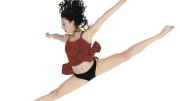Unlike teaching or medicine, the arts don’t offer an obvious mechanism for community service. Yet Anna Else Pasternak ’07, who grew up as both a California surfer and a versatile dancer (ballet, modern, jazz, Afro-Cuban, Afro-Brazilian) educated at San Francisco’s School of the Arts, had long hoped to find a way to combine dance with some form of social outreach. Last spring, she launched Movement Exchange (www.movementexchanges.org), and attracted an international group of volunteers to Panama to teach dance to orphans and other at-risk youth; on July 4, the artists performed with their students at Panama’s National Theater. Pasternak speaks Spanish fluently, but “The amazing thing about doing this with dance,” she explains, “is that the language barrier doesn’t exist. People connect.”
After college, Pasternak did some globe-trotting—traveling in the Middle East, for example, and teaching surfing in the Basque region of Spain—and fetched up in Panama, where she ran a volunteer program with European and American students for a nongovernmental organization (NGO), Global Brigades. Meanwhile, she wondered how to keep up her dancing. (In college, she had traveled to Cuba to pursue that passion, and also took time off to perform as a Brazilian passista—those samba-dancing women in spectacular, skimpy costumes celebrating Carnaval in Rio—for three months in Japan.) Fortuitously, she met Lila Troitiño, director of the National Ballet of Panama, who had recently launched her own NGO to connect social service and dance and was encouraging her dancers to volunteer with youths at risk.
Reflecting on “what a huge difference dance had made in my life, in things like self-esteem and body awareness,” Pasternak felt a click when she learned of the century-old Malumbo Orphanage outside Panama City, housing mostly girls, many HIV-positive, between the ages of nine and 17. Recognizing an opportunity, she invited members of a California dance network she belonged to down to Panama to teach the orphans dance. Panama’s minister of culture donated use of the baroque, century-old National Theater for a community dance event, and the U.S. embassy’s cultural-affairs department helped fund necessities like security at the theater.
Fourteen volunteers joined Pasternak that June; ranging in age from 17 to 48, they came from both coasts of the United States and even Singapore, and included modern dancers, ballerinas, a tap dancer, and a Chinese ribbon dancer. “What united them was their belief in dance as a way to foster cross-cultural understanding, self-esteem, and youth empowerment,” Pasternak says.
The National Theater event on July 4 put more than 70 dancers onstage; for many of the orphans it was their first public performance. Admission was free, and more than 250 people attended. “The U.S. embassy staff were beside themselves—they got a huge amount of great publicity,” Pasternak says. “And the best part of it all was the growth rate in the kids. You could see it backstage in things like trust.” (The original volunteers, who lived both at the orphanage and in the city during their visit, formed continuing relationships, now kept up on Facebook, with the Panamanian dancers.)
Donations made at the performance, and received from other sources, generated enough revenue to pay local teachers to maintain weekly dance classes at the orphanage. In January, Indiana University sent a second wave of dancers, who lived at the orphanage and worked each night with two other groups of at-risk youths. “We put together a kind of flash mob in a square in the old district of the city—bringing dance to the streets,” Pasternak says. “We did a huge performance in public.” Last year’s volunteer group, plus many additions, will return and prepare another National Theater performance this July 4.
“I feel like I did it backwards,” Pasternak says. “I’ve talked to people in Silicon Valley who are social entrepreneurs—they have this idea, then they build this website and try to find funding, and then implement the idea. I did all the implementation first, and all these things happened—but I didn’t have a website, didn’t write a mission statement, or plan things out.” Even now, Pasternak lives “nowhere—I have no home base.” She is applying for a Fulbright Scholarship in Mexico City, and is in love with the idea of international travel and “building communities through dance,” she says. “I also need to figure out how I’m actually going to make a living at this!”









